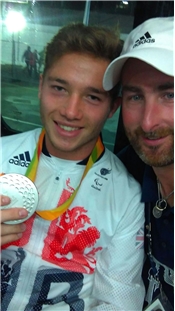
Interview with Stuart Wilkinson
By Mark Bullock
How did you get involved in coaching wheelchair tennis?
I was coaching at a park site in Hayes and we were running a buy ‘Buy one get one free’ on lessons and a lady called me and asked if I could do the free lesson straight after her paid lesson as she was travelling from Oxford (55min drive) . When she arrived she was in a wheelchair I was surprised - and I said to her if she had told me I would have done some research to which she replied if I had told you you would have said you were fully booked like the previous two coaches she had tried.
Which wheelchair players are you currently working with & what is your coaching philosophy with these players?
Since stepping down as the lead national coach I am working back in club tennis but still continuing to coach a few wheelchair players. The majority of my wheelchair tennis coaching hours is coaching Alfie Hewett who is the world ranked 2 player in singles and current British no.1. I am also coaching a group of wheelchair tennis players on an ad hoc basis at Brunel University.
My philosophy is the same with both level of players - keep the chair moving, prepare your racket so you can make contact with the ball on your terms and enjoy the challenge of using all the court all of the time. By this I mean try not to focus on the technical aspects of the shots but more the tactical implications of the shot you make. Create space - hit space.
You had huge success as a coach of many of Britain's top players. What were your highlights & why?
I am very privileged to have worked with all levels of wheelchair tennis players over the past 15 or so years. There are a few stand out moments and all have a very special meaning, coaching Pete Norfolk to Beijing gold in some difficult personal situations for him , coaching Andy Lapthorne to his first US Open Grand Slam singles title... Alfie Hewett to his first Roland Garos singles title are all obvious standouts for success.
However there are some highlights that are on par with this from Ade Adepitan winning the second draw singles title at the nationals , Marc McCarroll winning his first futures title in Israel , being the quad captain and winning the equivalent of the Davis Cup on 3 occasions and helping Jordy Whiley when she won her US open Grand Slam singles title.
Ultimately every player has a Grand Slam title moment whether it be at an actual Grand Slam or Paralympics or playing their first match. I have always tried to encourage them to reach their potential whatever that potential may be.
You have worked at all levels of wheelchair tennis. What advice would you give to clubs looking to start programmes?
I have three main advice points for people when working with players with a physical disability
1. Don’t be scared: talk to the player and understand what they can and can’t do physically and build their technical and tactical game around that
2. Teach solid tennis principals- wheelchair tennis is TENNIS - that means coaches know how to coach and can apply their experience and knowledge to a wheelchair tennis player to help them improve
3. Use the information out there through the LTA Tennis Foundation ITF YouTube etc to watch wheelchair tennis and learn the small differences there are i.e., movement patterns or reverse (inverted backhands).
You have also worked in deaf tennis. What have been your highlights in this area?
Deaf tennis was a fantastic experience for me. The players do not receive large financial support so are part time players much the same as all club players. The difference is mainly that each year there is a large event for deaf players - Dresse Maere (Davis Cup) Worlds or European championship or the Deaflympics - this means that for one event the standard the GB players play against is of an international Level as many of the foreign players are former (non deaf) world ranked standard. There is one player ranked top 150 ATP Lee Duck-hee from Korea who is deaf but plays in regular ATP Challenger events .
My highlights working with the deaf programme where helping to cultivate the junior performance players and seeing Esah Hayat win the junior singles world championship in Nottingham.
What advice would you give to coaches thinking of working with disabled players?
My advice is simple - coaches coach - don’t let a disability get in the way of doing what you do best. Be creative, find a way and work with the player to maximise potential.
Anything you would like to add?
Wherever possible try to be inclusive. It’s sometimes hard to have a number of disability players in one programme to make it profitable, so where possible integrate the disabled player into regular lessons or squads. Sometimes use the level of tennis as a guide rather than age banded. For example when wheelchair Marc McCarroll player started training at my club he would train with the green ball squad despite him being 22 years of age. Obviously you may need to have a conversation with parents to explain why the integration is happening but if everyone is working hard and the level of tennis is compatible it works fine.